
BYOD in Education
This report was adapted by Cantech Letter from a piece prepared by Sophic Capital. For the original report, and more in-depth research, please visit Sophic Capital’s website, here.
A trend to mobility is occurring inside and outside of the classroom. In the olden days of pencil and paper, too few students were engaged in lessons. They doodled, read books, or dipped pigtails in the inkwells. Today, disengaged students turn to mobile devices to chat on Facebook, check Twitter, and message their friends. While educators know students need to be tech savvy when they enter the workforce, today the challenge has been the inability to lock-down devices and keep students engaged. This challenge is compounded by the walled gardens imposed by the large device manufactures. Are schools to choose only one platform, one device, and force them upon the entire student population? The enterprise market has already experienced this problem and has adopted BYOD (bring your own device) programs almost unanimously. We believe the education market is next, and throughout this report we look at how the market is developing and some proposed solutions, especially by EXO U (EXO-TSXV), a Sophic Capital client.
The next transition is occurring in digital education – mobile learning. Although computer systems that engage students are firmly in place, the content delivery platform is evolving away from desktops. Mobile is the trend since it allows students the flexibility to extend learning outside the classroom, at the moment and the place they prefer. But this trend to mobility is not problem-free. Mobility requires the Internet, and the Internet can tempt students to web-chat or surf rather than focus on the lessons. The other issue is cost: Tablets and smartphones aren’t cheap. So to address this capital budget issue, several school boards have adopted a new policy, one where students supply their own mobile devices.
Bring your own device (BYOD) is a policy that allows students to use their own mobile devices to access educational content. The theory is that by allowing students to use their preferred devices, educational institutions can save money by not having to invest in mobile hardware. Teachers can also leverage existing technology investments (such as smart boards) that connect to student devices in order to create interactive lessons. From the student perspective, BYOD brings a multitude of benefits including: increased tech savviness, the lack of learning curves required to use school-issued devices, a sense of ownership over their learning experience, and collaboration on projects. But perhaps the greatest benefit to students is that they can learn at their own pace by accessing content outside of the classroom on their own devices whenever and wherever it suits them.
The transition to mobile learning can offer teachers tools for classroom management and real-time analytics on each student’s performance. BYOD platforms exist that put the teacher in charge. He or she controls the classroom; pushes content to her students’ devices; can get real-time feedback with analytics highlighting who absorbed the lesson, which can lead to enhancements to the teaching method and offer one-on-one help to students falling behind. These are powerful tools which teachers have longed for, although to date these full solutions have not been offered.
School Boards Recognize the Need for Mobile Learning
 A transition is occurring in the classroom. No, it’s not a shift towards computer-based learning, but a shift to computer-based learning on mobile devices. According to the Alberta Collaborative Online Resource Environment, student intellectual engagement typically declines from about 82% in Grade 1 to about 45% by Grade 12. Applying a “blended” learning environment, one where students learn inside and outside of the classroom, increases student engagement because they can learn at their own pace whenever and wherever they choose. But to do this, students need mobile devices. But who supplies and pays for the devices?
A transition is occurring in the classroom. No, it’s not a shift towards computer-based learning, but a shift to computer-based learning on mobile devices. According to the Alberta Collaborative Online Resource Environment, student intellectual engagement typically declines from about 82% in Grade 1 to about 45% by Grade 12. Applying a “blended” learning environment, one where students learn inside and outside of the classroom, increases student engagement because they can learn at their own pace whenever and wherever they choose. But to do this, students need mobile devices. But who supplies and pays for the devices?
Supplying students with mobile devices is costly. Education institutions are under financial pressure, as operating expenses often outpace budgets allocation, making it difficult to allocate funds to technology-based projects.” Legacy computing hardware is slow, breaking down, and clocking itself to death. Upgrading that hardware requires further investments in time, infrastructure, and maintenance. School boards issue requests for quotes and scrutinize every proposal under chemistry lab microscopes. Meanwhile, teachers want to know when it’s going to happen – when will students get those new tablets? Someone has to make a decision – a decision that parents and the school board would certainly dissect and assign responsibility if a costly investment fails. And failure is a possibility since cases abound with unsuccessful attempts to upgrade students’ hardware. But it doesn’t have to be that way: The world’s largest educational IT (information technology) project is progressing and could serve as a model for other nation-wide or even school district-wide initiatives.
Where is the world’s largest educational IT project occurring? The answer may surprise some, but Turkey is embarking upon the FATIH Project to place a tablet in the hands of every student from Grade 5 through 12. This colossal project involves almost 11 million students across 42,000 schools and 570,000 classes and also calls for interactive whiteboards in every classroom and lab. Halfway through 2014, Turkey’s Ministry of Education had distributed 731,886 tablets. This on top of the Ministry’s goal to install 101,644 whiteboards and 41,996 multifunctional printers by year-end.
But supplying students with school-issued hardware isn’t always successful. Exhibit 1 provides some unsuccessful attempts that school districts have had supplying students with mobile devices. Reasons why these projects fell short include: capital costs, vandalism, and theft. But as Exhibit 1 shows, many of the districts that scrapped initiatives to supply students with mobile devices refocused their efforts on a growing trend – leveraging student ownership of mobile devices.
U.S. kids have flocked to mobile phones and tablets. Maybe it’s because kids are more tech savvy than adults; maybe it’s because kids are smarter than adults; or maybe it’s because kids can’t survive without them; but U.S. kids have high ownership of mobile devices. Exhibit 2 shows that children aged 6 through 12 have higher tablet ownership than teens. The reverse is true concerning mobile phones.
Exhibit 1: U.S. School Districts are Adopting BYOD over School-Issued Hardware
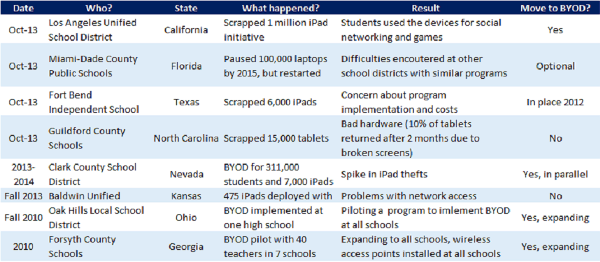
Exhibit 2: U.S. Children are Tech Savvy and Mobile Ready
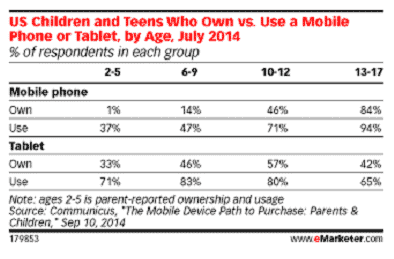
Let the Students Provide Their Own Mobile Devices
Rather than investing in computing hardware, many school districts have decided to let the students use their own devices to access learning content. And as Exhibit 1 showed, a transition towards letting students bring their own devices sometimes followed unsuccessful attempts to supply students with school-issued devices. The reasons for implementing BYOD are plentiful. First, pushing the hardware and maintenance costs onto the students preserves budget capital. Second, the students will likely engage more so on their preferred devices and operating systems. Third, students will take care of their devices since they or their parents have invested in the gadget. However, two significant problems exist with BYOD today.
IT Departments and Help Desks Struggle
BYOD needs a platform that can secure and unify various devices and operating systems. Implementing BYOD means delivering content to different operating systems (Microsoft, iOS, MAC OS X, various flavours of Android) and hundreds of different devices. These operating systems aren’t made to work together, and each has its own faults. This means that content doesn’t always make it to students’ devices, and when it does it may look and feel different for each student (Exhibit 3). As a result, frustrated teachers interrupt lectures to place calls to overwhelmed IT help desks, leaving disengaged students to idle. Also teachers are not able to easily direct students and seamlessly push relevant digital books and webpages to all of them.
Exhibit 3: The User Experience Across 400 Popular Websites Varies by Tablet
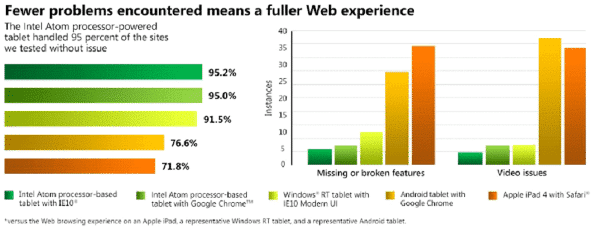
Those Nasty Apps Are a Threat to Data Security
Ach! Students download third-party apps for school and for play! Since students supply their own devices, BYOD tablets and smartphones pull double-duty as educational and personal devices. Given this, students will download apps for personal and educational use. So IT departments have to add another dimension to the different operating systems and hundreds of different BYOD devices: the hundreds of thousands of downloadable apps. Why are apps a problem? First, because they can distract students from the class, and second because many apps hide malware.
Be careful of those downloadable apps – they’re not as innocent as we think they are. Gartner predicts that by 2015, 75% of mobile applications will fail basic security tests. Each month, new mobile malware threats are discovered on the Android platform. Exhibit 4 shows that for the twelve months ending in July 2014, 45 new malware families had the potential to invade Android devices. And as Exhibit 5 illustrates, theft of information poses the greatest threat for mobile users. Therefore, any BYOD deployment must have policies and management tools to minimize these threats.
We believe that solutions that separate, encrypt, and secure educational data on BYOD devices are imperative and data security concerns. Several solutions for securing BYOD devices exist today. This was the focus for IT professionals for the last several years as many enterprises moved away from Blackberry-exclusive organizations to a BYOD model. We outline several players addressing security later in the report, but we believe cross-platform collaboration and classroom management are the challenges that IT departments are looking to solve now.
Exhibit 4: 45 New Malware Families for Android from August 2013 Through July 2014
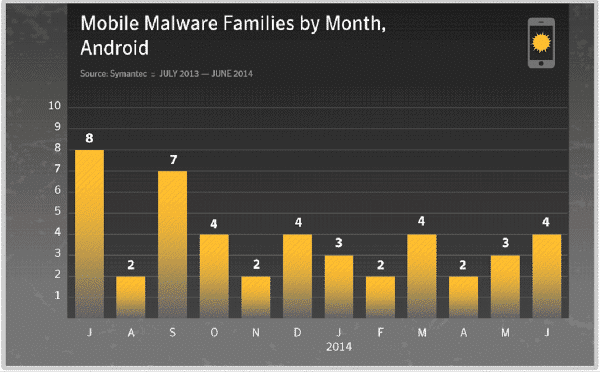
Exhibit 5: Theft of Information is the Greatest Mobile Threat
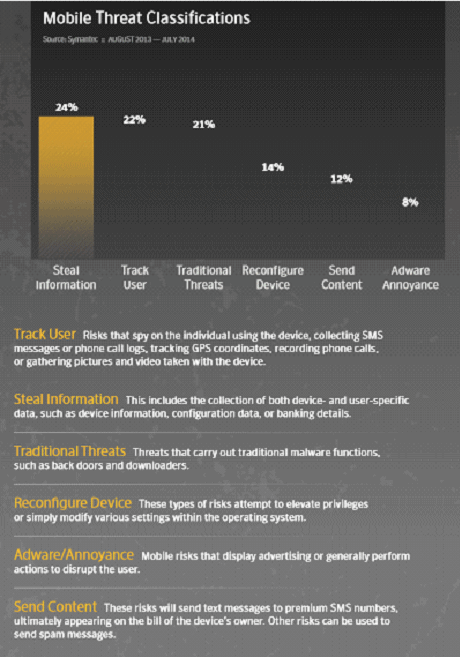
Without Planning, BYOD Could Be a Budget Liability
In some cases, BYOD has increased costs. Research suggests* that hardware comprises about 10% of an enterprise’s annual mobility budget. Don’t forget to add on wireless network upgrades and the hassle of managing non-uniform device platforms. These, along with carrier, help desk, developer, and mobile management costs, can quickly consume or surpass the budget. Many enterprises can reluctantly absorb these costs. However, non-profit organizations such as public schools with fixed and/or shrinking budgets cannot.
*Nucleus Research, Inc., Understanding the Hard ROI of BYOD, April 2013, pg. 1
Other Potential BYOD Problems in Educational Institutions
Some parents balk at connected classrooms. Most of the parental concerns we uncovered relate to children playing games, watching videos, or social networking. Cyber bullying and social status associated with certain devices are risks. Although we concede that social status is difficult to mitigate, systems exist which give teachers complete control of what content students access within the classroom. It’s unfortunate that teachers cannot control what some students share via their devices outside of the classroom to mitigate wider-spread cyber bullying.
Inequity. Not all students own the latest, cutting-edge devices. And school-issued devices quickly become obsolete. This can lead to some students having a poorer BYOD experience due to lack of computing horsepower. Worse, it can lead to bullying, mirroring the issues that prompted many schools to mandate school uniforms in order to blur the students’ economic classes. This technological inequality can lead to device theft or damage of higher-end devices. A choose your own device (CYOD) scheme, where students purchase school-approved mobile devices, would alleviate the potential for such problems since CYOD devices have no inequity. It is also anticipated that hardware will continue to become commoditized allowing schools to provide low cost alternatives that easily offer the horsepower required for classroom activities.
Productivity killer. Whether or not schools issue pen and paper or implement BYOD, not all students will engage. These students will keep themselves entertained one way or another. However, as we previously mentioned, BYOD systems exist that allow teachers to control all student mobile devices within the classroom. Although these systems cannot guarantee that every student will engage, they can eliminate online distractions that kill student productivity. We wonder if Mobira’s Talkman (left in the top photo) was ever a productivity killer.
Giving Teachers Control
Good classroom management serves three purposes. It engages students, keeps the students prepared, and boosts student and teacher confidence. I’m sure we’ve all seen what happens when teachers lose control; chaos can ensue resulting in wasted lessons.

As we mentioned previously, a sound BYOD strategy must include managing students’ online activities. A blanket policy of restricting web access at the network level can block the content that students require. We believe the best classroom management tools make a teacher the classroom server and network administrator. This is accomplished via a device (usually a laptop or tablet) that acts as an extra set of eyeballs on the classroom when the teacher is occupied. Students likely don’t enjoy this amount of surveillance and control because they can’t access diversionary content; nor can they do anything about it. But the ability to control content, push quizzes, and monitor student progress via learning analytics are powerful tools for teachers to effectively manage the lessons and create the best teaching/learning environment in the classroom.
Proactive Intervention with Learning Analytics
Learning analytics is the extrapolation of information from real-time data collected from students. In the past, teachers could only guess if students engaged and absorbed lessons. Quizzes and exams provided concrete evidence but couldn’t proactively identify students who needed help well before exam time. Some systems can also forecast which students may falter and then use the predictions to deliver customized content to bring students back up to speed so they don’t fall behind or, worse, fail.
One way for teachers to identify students at risk of falling behind is to push questions and quizzes onto students’ mobile devices. In this scenario, learning analytics systems not only identify which students answered incorrectly but also which students did not answer. Perhaps more important, the ability to push real-time content to all students gives the teachers control of the classroom. They can monitor their own performance, judge whether or not students are engaging, then adjust the lesson’s direction accordingly. If too many students answered a question incorrectly, a teacher can revisit that part of the lesson.
Another way for teachers to gauge student progress is via a learning analytics dashboard. Teachers can monitor how much each student engages with content. Are the students logging on? What did they download? What did they upload? Some systems even scan message boards to evaluate student sentiments regarding a course. All of these tools give teachers the power to intervene with struggling students.
Classroom Management Tool Available For Teachers
We begin by examining some educational sector BYOD leaders and then explore some up-and-coming entrants. We reiterate that a major shift is occurring within classrooms, the move from desktop to mobile learning. Many of the largest companies in the learning space began by providing desktop and non-cloud solutions. They provided the content, the analytic systems, and teacher control. Now that the trend has moved to extending student learning outside of the classroom, these companies have had to confront an entirely new line of business – unification.
D2L (Desire2Learn) – A Leader in Content and Analytics
D2L created Brightspace, which the company claims 15 million people across 1,100 organizations in 25 countries are using. Brightspace allows the teacher to organize, present, and manage content for students. Teachers can collect analytics and predict where each student needs help. Brightspace also provides feedback for students to gauge their progress. Most important, the platform puts the student at the center of the learning experience, allowing her to choose her own pace and path of learning.
In August 2014, D2L closed $85 million series B financing, bringing the total investment in D2L to $165 million. D2L plans to use the funds for continued market expansion and R&D. As shown in Exhibit 6, D2L is not shy about acquiring complementary technologies.
Exhibit 6: D2L Has a History of Acquiring Technology

SMART Technologies – Connecting Students and Teachers to Info
SMART Technologies (TSX: SMA, NASDAQ: SMT) designs interactive products and solutions that enhance the learning experience. The company is famous for its SMART Board, a whiteboard that displays content and allows teachers and students to interact with the teacher. SMART Board comes with SMART Notebook, software that allows teachers to create, share, and capture lessons and content. Lessons created with SMART Notebook can be shared through the SMART Exchange platform, a library of resources that are shared with the community. SMART Amp is a cloud education solution that allows ubiquitous learning. It enhances collaboration, content creation, communication, sharing and assessment from anywhere, on whatever device is being used. SMART Response is a handheld device that allows students to answer quizzes or provide lesson feedback. SMART Slate allows users to operate the Smart Board remotely. One significant outcome from this technology is student engagement, and when students engage, they are motivated to learn.
Stoneware – Offering a Unified Workspace
Stoneware, a Lenovo Company, offers education solutions that facilitates BYOD initiatives and management of the devices in the classroom. The company provides LanSchool, a classroom management solution. The software allows teacher to monitor, enable collaboration, remove distraction and assess student understanding. LanSchool is a cross-platform solution, but offers limited functionalities. WebNetwork delivers a unified cloud platform that allows teachers to securely deliver files, applications and reports to any devices.
Digedu – Delivering Personalized, Interactive, and Measurable Learning Experience
Digedu is an emerging digital education company providing a Learning Engine that allows teachers to create and deliver interactive lessons. Teachers can choose and customize one of the 3,500+ available lessons. The engine also allows teachers to gain insight on student performance with data analytics on performance, real-time assessments, and classroom management features. The Learning Engine also enables collaborative learning in the classroom. Digedu also offers a Classroom Cloud network that allows better management of schools’ bandwidth and local backups of data, enabling a better connected experience.
EXO U – Real-Time, Operating System-Neutral Collaboration
EXO U (TSXV:EXO), a Sophic Capital client, enables educational institutions and enterprises to securely manage information and empower people to communicate their best ideas. This innovative company has focused on simplifying the management of application lifecycles, allowing cross-platform, in-house app development which also minimizes malware threats. While letting developers focus on creating apps, EXO U’s agnostic framework takes care of app functionality across different mobile operating systems. It doesn’t matter if student devices run the gamut of operating systems; EXO U’s solution will handle them all. One solution for all operating systems and devices. No need for app developers to develop code for each operating system.
EXO U gives teachers control. No need for Internet connectivity either; teachers can push content from their own device (acting as a server) onto student devices via a classroom router. This means that the solution can be implemented in countries where Internet connectivity is spotty, and it also means that in periods when the Internet goes down the classroom carries on. The company has also built in full classroom management, allowing teachers to know when students are not in the classroom environment and giving teachers real-time analytics like the results of a pop quiz.
Although EXO U excels in unification and security, we believe the company has a larger strength – collaboration. One amazing feature of EXO U’s solution is the ability to collaborate between devices. We’re not talking about emailing videos or sharing files on the cloud. What EXO U and no one else (that we have found) does is real-time collaboration. A teacher or a student can select nearby devices (regardless of those device’s operating systems) and push his content or an app onto those devices. The user interface is the same across all devices, allowing a group to collaborate in real time. Seeing is believing, so we recommend that you take a look at this video to see what we’re talking about.
EXO U’s solution allows teachers to leverage existing capital investments such as smart whiteboards and projection systems. Being platform agnostic, EXO U’s solution can integrate existing equipment used in the classroom. Moreover, the open APIs (application programming interfaces) allow school systems to personalize the solution to their specific needs by developing new, cross-platform applications. These features also free institutions from walled garden technology, making sure that current decisions will not inhibit their ability to adopt future technologies.
EXO U’s solution was tested with more than 250 students in real classrooms. Pilot projects have successfully been completed in order to test the classroom management features. Teachers and students were impressed with the functionalities, the responsiveness and ease of use of the solution.
EXO U has a major, nation-wide customer. In June 2013, Panama’s National Secretariat for Science, Technology and Innovation signed a deal to deliver EXO U’s BYOD solution to 100,000 students.
BYOD Isn’t Limited to Education – Enterprises Want It Too
Many of the reasons for enterprises to implement BYOD mirror those of the educational sector. Enterprises benefit from shifting hardware purchase and maintenance costs to employees. By letting employees work on their preferred mobile gadgets (Exhibit 7) shows that 42% of U.S. adults have a tablet and 90% own a cell phone,) workers can quickly ramp into their roles rather than face a learning curve with a company-issued device. This leads to productivity enhancements, worker accessibility, and potential recruiting advantages (83% of Millennials own a smartphone, and they typically embrace their preferred platforms for work and for play.)
Tech Pro Research estimates that 74% of organizations use or plan to use BYOD. Two years ago, 62% of organizations used or planned to use BYOD.
BYOD within the enterprise suffers the same risks as educational institutions, paramount of which is data protection. Data accumulation is costly. Think of the time it takes to collect, organize, and secure data. Then think about the number of people in your organization who do likewise. You’ll probably find that the human capital, network, storage, compliance, and time costs balloon.
Data breaches are costly. Costs vary by country, due to the types of attacks and data protection laws. To determine the average cost to an enterprise when data breaches occur, Ponemon Institute conducted a study across 277 organizations in 16 countries. As Exhibit 8 shows, the costs are significant, therefore, we believe enterprises can benefit by issuing corporate approved apps that are either developed in-house or licensed from approved third-parties. Furthermore, we recommend that enterprises implement platforms that contain, encrypt, and secure corporate data and apps on employee devices.
Exhibit 7: 42% of American Adults Owned a Tablet in 2014
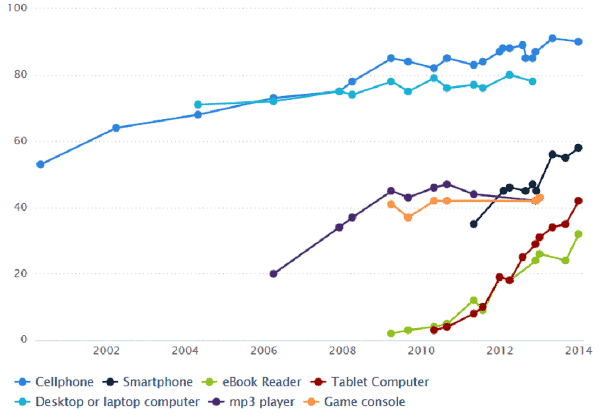
Exhibit 8: Average Cost of a Data Breach for Organizations in Various Countries
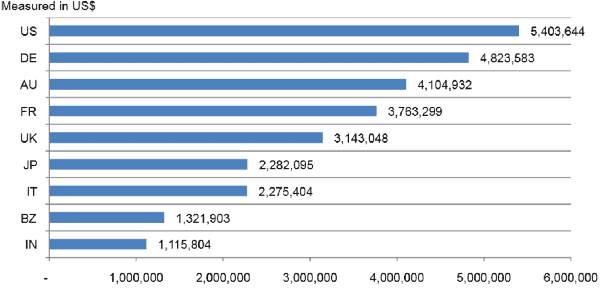
Don’t neglect employees’ perceived lack of privacy. At one time, employees could expect privacy on all their devices. In its infancy, BYOD policies were more of an implied code of behavior. Then, enterprise legal departments took over and, in many cases, drafted strict, detailed policies which gave enterprises the right to monitor, search, and wipe employee-owned devices. From the employee’s perspective, enterprises became Big Brother, but, in reality, enterprises implemented these policies to safeguard data. This resulted in clashes between employees and employers which destroyed trust and the claimed productivity benefits that BYOD was supposed to provide.
Market Forecasts
The global BYOD market could reach about $266 billion by 2019 according to MarketsandMarkets. This growth comes from a 2013 base of about $72 billion and includes BYOD in both educational institutions and enterprises. Grand View Research predicts the BYOD market to grow from about $65 billion in 2012 to approximately $238 billion by 2018. Juniper Research forecasts that over one billion of the smartphones and tablets used in the enterprise will be employee-owned. This represents 35% of the total installed base of consumer-owned smartphones and tablets.
According to TechNavio, the BYOD security market CAGR could be about 32% from 2013 through 2018. The total mobile security market (personal and enterprise) is forecasted to be worth $4.5 billion in 2014. Compounding the 2014 $4.5 billion forecast by 32% per annum suggests that the mobile security market could be worth $13.7 billion by 2018.
M&A Activity is Strong
Major technology companies have snapped up BYOD firms. Exhibit 9 demonstrates that M&A activity is robust, with blue-chip companies making acquisitions to tap into this burgeoning market.
Exhibit 9: The Biggest Tech Companies are Snapping Up BYOD Companies
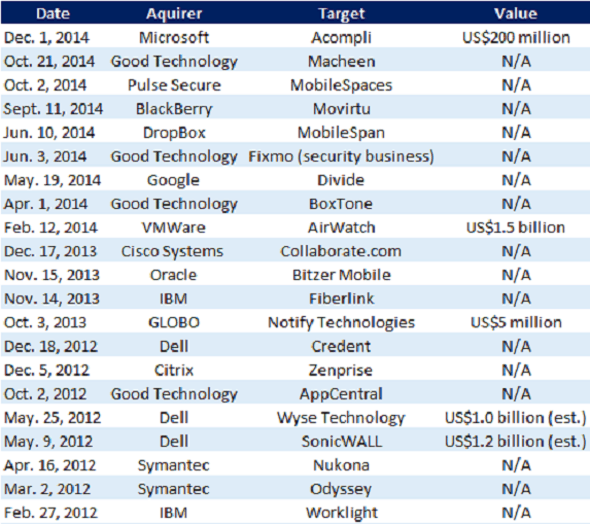
Notable BYOD Players
A broad range of companies exist in the BYOD sector. They range from microcap start-ups to the largest technology blue-chips. We provide a brief summary of some of them.
Absolute Software (TSX:ABT) has an extensive portfolio of enterprise solutions that includes BYOD data security, remote device management, and content management. The company holds a patent on its “Absolute persistence” technology, a firmware based solution that allows enterprises to maintain a connection with all devices even if the Absolute Manage and Computrace software agents are removed from the device.
Alcatel-Lucent (NYSE:ALU) offers a fully integrated BYOD solution. In 2013, Alcatel-Lucent provided integration of its core operating system with ClearPass, a network control solution from Aruba Networks, Alcatel’s long-time partner. ClearPass Policy Management Solution allows users to register their devices, separate personal and enterprise usage, and download approved apps, while letting ClearPass provide updates and security controls.
Centrify provides unifying identity management solutions for cloud, mobile, and data IT environments. It offers centrally controlled security and compliance solutions that secure and audit mobile devices and applications.
Cisco Systems (NASDAQ:CSCO) offers a comprehensive BYOD solution architecture, combining elements across the network for a unified approach to secure device access, visibility, and policy control.
Good Technology has made several acquisitions in the BYOD space over the past two years. Last year, it acquired Fixmo’s security business to strengthen its solutions’ security and scalability. The BoxTone acquisition brought a mobile management platform into Good’s end-to-end secure mobility solution. AppCentral, acquired in 2012, added the ability to secure and manage mobile apps.
IBM (NYSE:IBM) formed a partnership with Apple in July 2014 to bring Apple devices to the enterprise. We view this as a validation of this space, given that IBM once disallowed iCloud and Siri, Apple’s intelligent assistant. Enterprise workers are bringing iOS products to the workplace, and IBM plans to build a portfolio of enterprise-specific apps and provide a range of cloud and security services.
MobileIron (NASDAQ:MOBL) is staking its future on the belief that mobile IT will become the primary means by which enterprises deploy applications and workers access corporate information. The company has achieved success with over 6,000 customers since 2009, and in the first 9 months of 2014 has almost matched the $100 million in revenue it generated in 2013.
Samsung’s (KRX: 00593) latest BYOD offering is the KNOX 2.0 platform. The data app and security platform uses a security-enhanced version of Android, which creates containers to separate personal from enterprise data. KNOX also comes with Marketplace, an app store geared towards IT administrators seeking cloud-based work solutions.
VMWare (NYSE: VMW) is a virtualization software company that allows IT to deliver services from any device at any time. The company’s Workspace Portal solution allows IT to provide app stores to enterprises, compliance reporting, and lifecycle management.
Notable Learning Management and Analytics Players
Moodle is a free learning management system that allows educators to create their own private website that allows students to learn any time and from anywhere. Teachers can upload content, conduct quizzes, and facilitate collaboration amongst students. Moodle claims that over 70,000 schools, universities, and corporations across 200 countries and 100 languages use the platform for their online learning requirements.
Edmodo has connected teachers to students in 88 of the 100 largest schools districts in the U.S. Its learning management systems, whose features were driven by teacher feedback, provide teachers with seamless communication with students, teacher-generated content, educational apps, and accessibility from any device. Edmodo has over 45 million members using the platform.
Blackboard provides educators with a suite of platforms to enhance and manage the teaching/learning experience. Its Blackboard Analytics suite allows users to data mine, extract information, and organize it into dashboards for easy access. Although geared towards higher education, we believe the learning analytics feature is applicable to any school or enterprise e-Learning program. The Blackboard Learn platform enables teachers and students to collaborate, communicate, organize study sessions, and book appointments for one-on-one help.
Schoology’s learning management system has 7.5 million users across 200 countries. Free for teachers to use, Schoology provides organizing and monitoring tools similar to competitors’ platforms. But Schoology also connects educators across the globe to share best practices, similar to what Edmodo provides to its global network of certified teachers.
McGraw-Hill is an education content provider that has moved into the classroom analytics space. In March 2014, the company introduced Connect Insight, a data analytics tool for higher education. This mobile tool allows teachers the ability to make real-time, data driven decisions regarding their instruction techniques, effectiveness of assignments, and whether students are struggling. The tool analyses real-time big data, freeing teachers from having to sift through mounds of data in order to extrapolate information.
Conclusions
Educational institutions have deployed BYOD, sometimes nation-wide, and we believe BYOD will get bigger. Legacy computers need upgrading, and school districts are turning to mobile devices. Some attempts to issue mobile devices have failed, so school boards are looking to leverage the mobile devices that students are bringing to school. There are numerous advantageous to deploying BYOD (decreased capital costs for schools, teacher control of the classroom, and increased student engagement.) There are also several risks (data security, malware from third-party apps, and unification of devices and platforms) which we believe current BYOD platforms can mitigate.
Enterprises also seek to leverage employee mobile devices but struggle to balance data security with employee rights to privacy. Reduced costs, 24/7 employee access, and enhanced employee productivity motivate enterprise BYOD investments. However, employee downloads of third-party apps leaves corporate data susceptible to malware attacks. Solutions exist to contain corporate data, and policies mandating approved work-related apps can secure enterprise data. Aggressive enterprise BYOD policies can alienate a workforce thereby reducing trust and productivity enhancements. Enterprises must draft and communicate BYOD policies that do not alienate employees due to breaches of privacy.
M&A activity is robust. Companies offering BYOD solutions range from microcaps and start-ups to blue-chip technology giants. M&A has been healthy, and we believe will continue to grow along with this evolving marketplace.
We recommend that investors seeking a pure-play BYOD company consider EXO U (TSXV: EXO), a Sophic Capital client. EXO U serves both the educational and corporate sectors. Its platform seamlessly unifies devices and allows teachers to control classrooms. However, we believe that the ability of EXO U’s platform to allow true collaboration between devices is a strong differentiator that introduces a new level of learning in the classroom.
Disclaimers
The particulars contained herein were obtained from sources that we believe to be reliable, but are not guaranteed by us and may be incomplete or inaccurate. The opinions expressed are based upon our analysis and interpretation of these particulars and are not to be construed as a solicitation of offer to buy or sell the securities mentioned herein. Sophic Capital Inc. (“Sophic Capital”) may act as financial advisor, fiscal agent or underwriter for certain of the companies mentioned herein, and may receive remuneration for its services. Sophic Capital and/or its principals, officers, directors, representatives, and associates may have a position in the securities mentioned herein and may make purchases and/or sales of these securities from time to time in the open market or otherwise.
Leave a Reply
You must be logged in to post a comment.




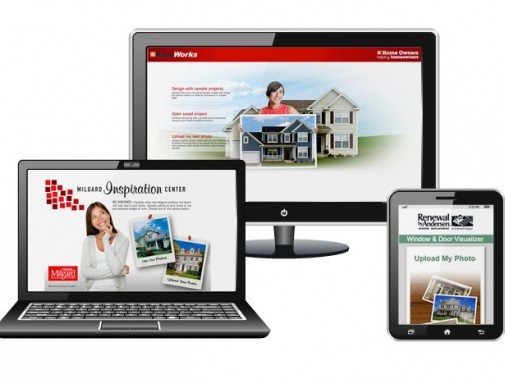
 Share
Share Tweet
Tweet Share
Share




Comment